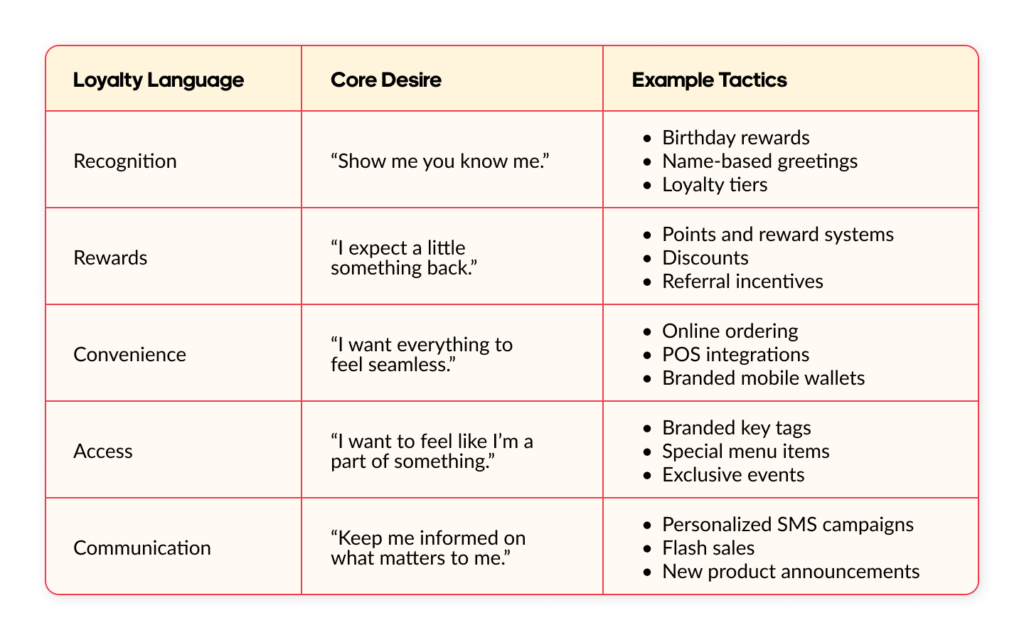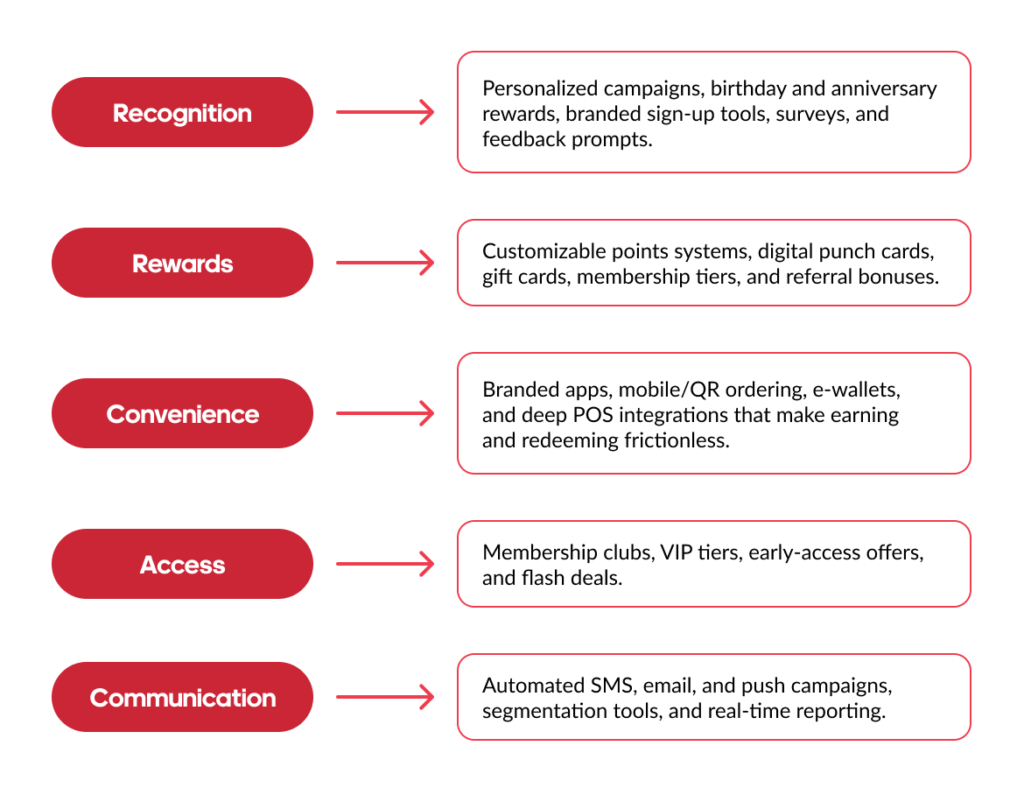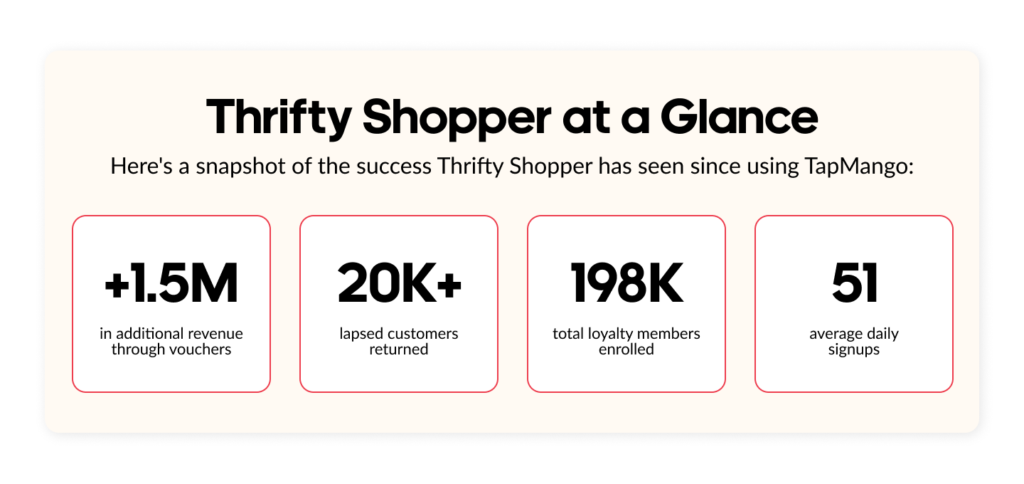
The 5 Customer Loyalty Languages
If you run a restaurant, retail store, or service business today, you’ve probably felt the pressure: customers have more options than ever, competition is fierce, and the cost of acquiring new customers keeps climbing. It’s no surprise that many businesses turn to loyalty programs to hold onto the customers they already have.
But here’s the problem: too often, “loyalty” gets reduced to points and punch cards. Customers earn. They redeem. They forget. Customer loyalty programs become just another marketing checkbox rather than a true growth driver.
What most businesses don’t realize is that the tools alone aren’t enough. Without a clear strategy, even the most feature-rich program will fail to create the kind of emotional connection that makes customers return again and again.
That’s where TapMango comes in. Over the past 12+ years, we’ve worked with thousands of merchants across industries, processed billions of transactions, and helped businesses of all kinds grow with an industry-leading customer loyalty and engagement platform. Along the way, we’ve discovered one simple truth:
Loyalty only works when it’s human.
Customers don’t just want discounts; they want to feel seen, valued, and connected. That’s why we created the 5 Loyalty Languages™ framework—a new way for SMBs and mid-market businesses to understand customer loyalty strategies and put them into practice.
The Problem With Loyalty Today
For many business owners, loyalty is something you “check off the list.” You sign up for a POS add-on or launch a punch card program and call it done. The problem is, those solutions rarely move the needle.
Customers are inundated with offers and promotions every day. If your loyalty program is just a discount engine, they’ll ignore it—or worse, they’ll jump ship as soon as a competitor offers a slightly better deal.
Meanwhile, merchants feel stuck. They know they need to “do loyalty,” but they’re not sure how to make it stand out. They launch programs that look just like everyone else’s, then wonder why customers don’t seem to care.

It’s not that points and discounts are bad—they’re just incomplete. A true loyalty program needs to be rooted in strategy, not just mechanics. That means understanding what your customers actually value and designing your program to meet those desires in a way that feels personal, consistent, and brand-aligned.
Our perspective is simple: loyalty is not a checkbox. It’s a practice. And like any practice, it requires intention, consistency, and the right framework to guide it.
Introducing the 5 Loyalty Languages™
The inspiration for our framework comes from a familiar place: the “Love Languages.” Just as people express and receive love in different ways, customers experience loyalty in different ways.
Some want to be recognized for who they are. Some want to be rewarded fairly for their purchases. Some want everything to be as seamless as possible. Others want the feeling of exclusivity, of being an insider. And almost everyone wants clear, timely communication.
That’s why we developed the 5 Loyalty Languages™. It’s a simple, human-centered framework that makes customer loyalty strategies easier to understand—and easier to implement.
Here are the five:
- Recognition – Customers want to be seen and valued. From a birthday message to remembering their last purchase, recognition is about showing customers you actually know them.
- Rewards – Customers expect a fair give-and-get. They want to feel that their loyalty pays off in ways that are meaningful, fun, or even surprising.
- Convenience – Customers want everything to feel seamless. The easier you make it to buy, earn, and redeem, the more likely they are to stay engaged.
- Access – Customers want to feel like insiders. They want perks, VIP experiences, and early access to specials that make them feel part of something bigger.
- Communication – Customers want relevant updates. They don’t want spam—they want timely, personalized messages that help them get more value from your business.
Together, these five Loyalty Languages form the foundation of a loyalty strategy that actually works. They’re intuitive, easy to remember, and rooted in real human behavior.

Loyalty Isn’t New, It’s Just Underleveraged
The Loyalty Languages aren’t abstract theory—you see them play out every day. The businesses that get it right build loyalty that lasts. The ones that don’t? They create noise.
The Generic Text Problem
A neighborhood café sends out three “buy one, get one” promos a week. The problem? The messages rarely match what customers actually want. Instead of drawing people in, they train customers to swipe the notifications away. That business has the right tools, but no strategy. They’re missing Recognition and Communication.
Gamified Rewards That Stick
Now contrast that with Chipotle’s “IQ Test” trivia game. Customers played along with trivia questions and challenges because it was fun, engaging, and came with the promise of free food. That’s a brilliant combination of Rewards and Communication—customers felt like they were earning something and having fun doing it.
Making Customers Feel Seen
Delta Airlines consistently scores high in customer loyalty because it makes frequent flyers feel recognized. From surprise upgrades to personalized service touches, Delta taps into Recognition and Access. These tactics make Delta flyers feel like valued individuals, not just another ticket or transaction.
Convenience as a Loyalty Driver
Amazon Prime is the ultimate example of Convenience and Access. Customers aren’t loyal because of one perk—they’re loyal because the experience is seamless: fast shipping, free returns, bundled entertainment, and exclusive deals. It removes friction at every step.
What’s important is that these aren’t just “big brand” lessons. The same customer loyalty strategies apply to local restaurants, consignment shops, nutrition stores, and med spas. For example:
- A local QSR can mirror Chipotle’s gamified approach by offering challenges inside their branded app—like “Buy a smoothie three times this month and unlock a free topping.”
- A consignment store could borrow from Delta’s playbook by giving VIP customers early access to new arrivals.
- A med spa could replicate Amazon’s frictionless model with subscription packages and priority booking for loyal members.
Whether you’re running one location or a growing chain, learning to speak these Loyalty Languages makes your program more than just another app on your customer’s phone—it makes it a driver of customer engagement and client retention.
How TapMango Helps You Speak the 5 Languages
Most businesses struggle because they only focus on one Loyalty Language (at most) and ignore the rest. TapMango changes that.
Our platform was built to give merchants the ability to activate all five Loyalty Languages, seamlessly and under one roof. Here’s how:

Our platform is packed with all the features you need to speak the 5 Loyalty Languages, so you don’t need to cobble together multiple tools or sacrifice strategy for simplicity. You just get a comprehensive loyalty program strategy designed to grow with your business.
Why Now?
Customer loyalty has always mattered. But right now, it matters more than ever.
Attention spans are shorter. Competitors are everywhere. Customers expect personalization and convenience, and if they don’t get it, they’ll move on. In fact, research shows that even a small increase in customer retention can have a dramatic impact on profitability.
The problem is, most loyalty solutions treat loyalty as a checkbox. POS providers add it as a side feature. Discount apps offer a one-size-fits-all template. None of them give you the strategy you need to actually increase repeat business.
That’s where TapMango stands apart. We’ve been loyalty-first since day one. With more than a decade of experience, billions of transactions, and thousands of merchants served, we know what it takes to make loyalty your growth engine.
The time to act is now. Businesses that implement a loyalty strategy today will be the ones customers are still visiting years from now.
Loyalty Is Our First Language. Ready to Make It Yours?
The 5 Loyalty Languages™ are more than a framework—they’re a way of thinking about your customer loyalty that goes beyond discounts and points. They help you see loyalty as a human practice, not just a program.
And we know this approach works. Take Thrifty Shopper, a nonprofit thrift chain powered by TapMango. By leaning into Rewards and Communication through vouchers, they sold over $1.5 million in prepaid vouchers and reactivated more than 20,000 lapsed customers. That’s the power of combining features with strategy.

At TapMango, we don’t just provide the tools. We provide the expertise and the framework to make them work. We like to say Loyalty is our first language. Are you ready to start speaking your customers’ Loyalty Languages? Request a demo today and let’s build your loyalty strategy together.

